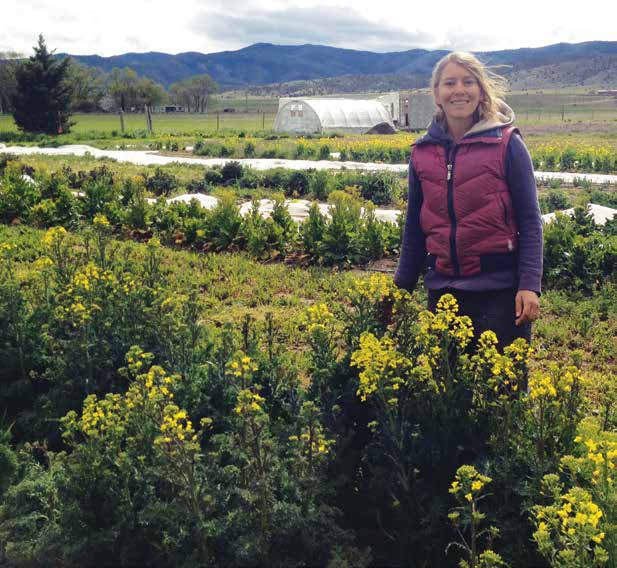Seeds To Live By
Stewarding Well With Homeward Bounty Farms…..
The seeds of farmer Kate O’Brien-Mann’s journey back to Siskiyou County were planted in her youth. “Probably like a lot of teenagers, I never thought I would live in Siskiyou County as an adult. Then, I started getting curious about farming in college.”
An international studies major, O’Brien-Mann’s interest in agriculture was piqued by a professor who had worked in Africa on food relief programs. “I became interested in how food moves around the world, whether it’s through aid relief programs or subsidy programs, as well as that big economic picture of global agriculture.” At the same time, O’Brien-Mann began putting in some hours each week volunteering on a CSA farm. “It was such a juxtaposition to what I was studying because it was this super small local economic circle of, wow, your food is moving like 10 miles.”
O’Brien-Mann fell in love with small scale economics. “I get to be working with people and food and access, and I’ve just kind of been farming ever since.” Then, in 2012 in her mid-20s, O’Brien-Mann returned to Siskiyou County. “I moved back home kind of curious about the ag scene here,” explains O’Brien-Mann. “The thought really appealed to me to be able to spend time in the community that raised me and to be able to give back.” It was a very personal journey homeward as a way to “grow food and seeds to share” with the community she loves. Just like that, Homeward Bounty Farms was born.
Located on about 40 acres in Grenada under the majestic shadow of Mt. Shasta, the growing season on the farm can be tricky. “Our little farming community is super tight knit. There aren’t a ton of us because it’s kind of an extreme area to try and grow diversified food crops.” But the challenge hasn’t stopped O’Brien-Mann. For the last eight years, she has done a lot of growing fresh produce for the markets, especially in Mount Shasta.

These days, however, she has turned more of her attention to growing plants for seeds. “At first, I pursued that as a hobby just to be able to grow seed from stock that I had saved. And then I was growing seeds on a larger scale to sell to seed companies. I did that for many years and then I thought, you know, maybe I should package up and sell seeds that do really well in our region because the more I farmed here, the more I realized growing out a variety and selecting for the characteristics that thrive here in Siskiyou County, there’s really a lot of value to that.”
When planting for seeds instead of fresh market produce, there are a number of different factors to consider. “It’s definitely still farming, as there’s still a ton of risk involved. Like, at any second, something could wipe you out. You have these beautiful melons in the field that you want to overripen to make sure that the seed has picked up all those nutrients. But it’s also just screaming out with sweetness to a ground squirrel. So, with seeds, it’s a longer game of stewarding things,” O’Brien-Mann explains.
Because plants are in the ground a lot longer, it also puts them at higher risk of pests, mold and mildew. “It’s important to make sure there’s good air flow. I also have to make sure I’m planting a large enough population size because I want that genetic diversity.”
As a small-scale farm, space can present a challenge. “I will do some timed isolation with some species where I’ll get something in really early in the season and then a few months later I can plant another variety of the same species. As long as they’re blooming at different times I don’t have to worry about the wind or insects crossing those pollen sources.”
The level of planning that goes into seed craft actually makes winter on the farm quite busy. Just like the deep, unseen work being done in the soil by worms and micro-organisms, O’Brien-Mann is prepping for her garden. “In winter, I draw up a detailed crop plan because the thing about these babies is you have to really be aware of isolation distances. Sometimes, however, even the best laid crop plans don’t work out. “The struggles are real. You invest three months, four months, five months into something, and then in a second it can be gone and you have nothing to show for all that time. It is a labor of love.”
For O’Brien-Mann, however, the benefits outweigh the risks. “In the end, you never question whether what you’re doing serves a greater good and a greater purpose. I love knowing that I’m feeding people, knowing that food is coming off my farm and being enjoyed short distances away at the peak of its nutrition. It doesn’t get better than that.”
Like the seeds and seasons she lives by, O-Brien-Mann’s own life seems to echo the patterns to which she has become so attuned. “My parents still live here. And, right now I’m pregnant with our second child.” She smiles as she reflects on the deeper meaning of that. “I’m back where I grew up in Grenada and my kids will probably go to Grenada, so it’s kind of this funny full circle.” Such is the cycle of life.•
Homeward Bounty Farms • homewardbountyfarm.com




